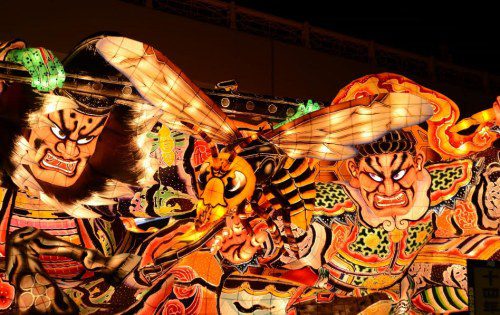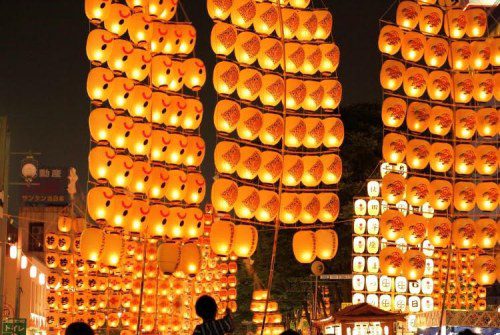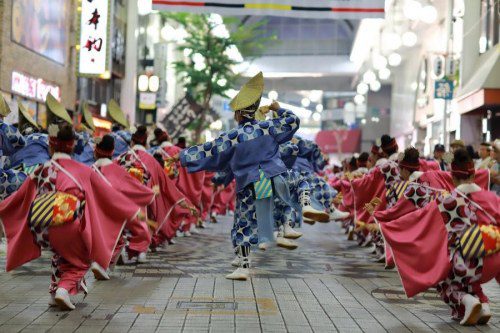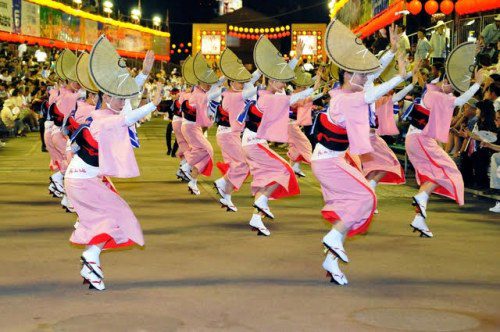As the weather warms and the days draw longer, summer in Japan is a time to celebrate with colourful and vibrant festivities taking place around the country. From giant paper statues towering above the crowds and lanterns illuminating the night sky, to mesmerising fireworks displays and captivating dance performances, here are some of the most energising cultural festivals in Japan to put on your summer travel radar.
Nachi no Ogi Matsuri, July 14
In Nachikatsuura, Wakayama Prefecture, the annual grand festival of Kumano Nachi Taisha Shrine takes place on the 14th of July each year. Named the Nachi no Ogi Matsuri (Nachi Fire Festival), the festival is a sacred ritual where the deities return to Nachi Falls to revitalise their divine power.
The festival highlight takes place in front of Nachi Falls where the stone steps between the shrine and the waterfall become filled with men in white robes dancing and carrying 12 large flaming torches. Each torch represents one of the 12 spirits living in the Kumano mountains and is said to weigh around 50kg.

Nachi no Ogi Matsuri. Image by JNTO
Owari Tsushima Tenno Festival, July
Typically taking place on the last weekend of July, the Owari Tsushima Tenno Festival has been taking place for around 600 years. Aichi’s Tenno River is the focal point for the two-day festival which features musical performances and a procession of boats extravagantly decorated with tapestries that float down the river as bands play music from the decks. At night, the boats become illuminated with hundreds of lanterns, making for an incredible spectacle of light reflecting from the water as fireworks light up the skies above. The river banks are a popular place for visitors to enjoy the festivities and enjoy the many festival food offerings.
Aomori Nebuta Festival, August 2 – 7
Taking place in Aomori City in the north-eastern Tohoku region, the Aomori Nebuta Festival attracts around 2.5 million people every year. Highlights of the festival include the enormous 3-D nebuta (dramatic human-shaped floats made with papier mache) that parade through the city, taiko drumming performances, and the 2-hour-long fireworks display on the last day to close the festival. People are invited to participate in the festivities along with hundreds of dancers while wearing one of the haneto dancing costumes which can be bought or rented.

Aomori Nebuta Festival. Image by JNTO
Akita Kanto Festival, August 3 – 6
Believed to date back to the 17th century, the Akita Kanto Festival is held each year as a way to pray for a good harvest of the five grains: wheat, rice, beans, foxtail millet, and Chinese millet. The festival is especially known for its parade of 12-metre-high bamboo poles which are each decorated by as many as 46 lanterns illuminated by candlelight. People dressed in traditional festival costumes take turns hoisting the poles into the air while parading through the town to the rhythm of flutes and drums.

Akita Kanto Festival. Image by JNTO
Yosakoi Festival, August 9 – 12
During the Yosakoi Festival which has taken place for more than 60 years, Kochi City in Shikoku comes alive with over 10,000 dancers who flood the streets with their naruko (wooden clappers) and energetic moves. Beginning with a fireworks display, dancers are accompanied by spectacular floats that move through an infectious party atmosphere decorated with colour. The end of the festival is marked with a dancing competition which sees one of the dance teams awarded as the year’s best dance group.

Yosakoi Festival. Image by Shikoku Tourism
Awa Odori Festival, August 12 – 15
With a 400-year history, the Awa Odori Festival is said to draw crowds of over one million people in Shikoku’s Tokushima City. The festival highlight is the Awa Odori dancing which takes place in the streets of Tokushima involving people of all ages wearing happi and yukata (traditional dress) while they dance. Music with traditional local instruments including flutes and drums, acrobatic dance performances on one of the festival’s several stages and street food stalls along the banks of the city’s river are key attractions of the festival.

Awa Odori Festival. Image by Tokushima Prefecture




















